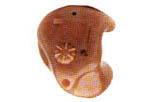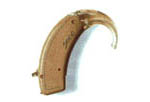Hearing Aids for Children
What are hearing aids?
More children will lose their hearing later in childhood. Hearing aids can help improve hearing and speech, especially in children with sensorineural hearing loss (hearing loss in the inner ear due to damaged hair cells or a damaged hearing nerve). Sensorineural hearing loss can be caused by noise, injury, infection, certain medications, birth defects, tumors, and problems with blood circulation.
Hearing aids are electronic or battery-operated devices that can amplify and change sound. A microphone receives the sound and converts it into sound waves. The sound waves are then converted into electrical signals.
What are the different types of hearing aids?
The type of hearing aid recommended for your child will depend on several factors, including his or her physical limitations, medical condition, and personal preference. There are many different types of hearing aids on the market, with companies continuously inventing newer, improved hearing aids. However, there are 4 basic types of hearing aids available today. Consult your child's health care provider or audiologist for additional information on each of the following types:
|
In-the-ear (ITE) hearing aids
|
These hearing aids come in plastic cases that fit in the outer ear. Generally used for mild to severe hearing loss, ITE hearing aids can accommodate other technical hearing devices, such as the telecoil, a mechanism used to improve sound during telephone calls. However, their small size can make it difficult to make adjustments. In addition, ITE hearing aids can be damaged by ear wax and drainage.
|
|
Behind-the-ear (BTE) hearing aids
|
Behind-the-ear hearing aids, as the name implies, are worn behind the ear. This type of hearing aid, which is in a case, connects to a plastic earmold inside the outer ear. These hearing aids are generally used for mild to severe hearing loss Behind-the-ear hearing aids are typically the style of choice for young infants and children. Poorly fitted BTE hearing aids can cause feedback, an annoying "whistling" sound, in the ear. However, all types of hearing aids may cause feedback if poorly fitted.
|
|
Canal aids
|
Canal aids fit directly in the ear canal and come in two styles: in-the-canal (ITC) aid and completely-in-canal (CIC) aid. Customized to fit the size and shape of the individual's ear canal, canal aids are generally used for mild to moderate hearing loss. However, because of their small size, removal and adjustment may be more difficult. In addition, canal aids can be damaged by ear wax and drainage.
|
|
Body aids
|
Generally reserved for profound hearing loss, or if the other types of hearing aids will not accommodate, body aids are attached to a belt or pocket and connected to the ear with a wire.
|
Who may be a candidate for hearing aids?
Most children who have a hearing loss that may be improved with hearing aids can benefit from these devices. The type of hearing aid recommended may depend on several factors, including, but not limited to, the following:
-
The shape of the outer ear (behind-the-ear hearing aids may not fit deformed ears)
-
Depth or length of depression near the ear canal (too shallow ears may not accommodate in-the-ear hearing aids)
-
The type and severity of hearing loss
-
The manual dexterity of the child to remove and insert hearing aids
-
The amount of wax build-up in the ear (excessive amounts of wax or moisture may prevent use of in-the-ear hearing aids)
-
Ears that require drainage may not be able to use certain hearing aid models
Wearing a hearing aid
Once the hearing aids have been fitted for the ears, your child should begin to gradually wear the hearing aid. Because hearing aids do not restore normal hearing, it may take time to get used to the different sounds transmitted by the device. The American Academy of Otolaryngology recommends the following when beginning to wear hearing aids:
-
Be patient and give your child time to get used to the hearing aid and the sound it produces.
-
Start in quiet surroundings and gradually build up to noisier environments.
-
Experiment where and when the hearing aid works best for your child.
-
Keep a record of any questions and concerns you have, and bring those to your child's follow-up exam.
Taking care of hearing aids
Hearing aids need to be kept dry. Methods for cleaning hearing aids vary depending on the style and shape. Other tips for taking care of hearing aids include the following:
-
Keep the hearing aids away from heat.
-
Batteries should be replaced on a regular basis, usually every 1 to 2 weeks.
-
Avoid the use of hairspray and other hair products when the hearing aid is in place.
Considerations when purchasing a hearing aid
A medical exam is required before purchasing a hearing aid. Hearing aids can be purchased from an otolaryngologist (a doctor who specializes in disorders of the ear, nose, throat, and related structures of the head and neck), an audiologist (a specialist who can evaluate and manage hearing and balance problems), or an independent company. Styles and prices vary greatly. Consider the following questions when buying hearing aids:
-
Can the hearing loss be improved with medical or surgical interventions?
-
Which design will work best for my child's type of hearing loss?
-
May my child "test" the hearing aids for a certain time?
-
How much do hearing aids cost?
-
Do the hearing aids have a warranty and does it cover maintenance and repairs?
-
Can my child's audiologist or otolaryngologist make adjustments and repairs?
-
Can any other assistive technological devices be used with the hearing aids?
For more information go to www.riversidehealthcare.org/hearing-aids.html